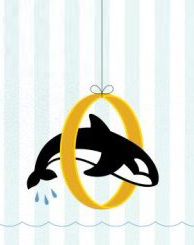 Amy Sutherland has written a short, amusing book called “What Shamu Taught Me About Life, Love, and Marriage: Lessons for People From Animals and Their Trainers.”
Amy Sutherland has written a short, amusing book called “What Shamu Taught Me About Life, Love, and Marriage: Lessons for People From Animals and Their Trainers.”
Sutherland attempted to adopt animal training techniques with her husband. “I adopted the trainers’ motto: ‘It’s never the animal’s fault.’ When my training attempts failed, I didn’t blame Scott. Rather, I brainstormed new strategies, thought up more incompatible behaviors and used smaller approximations. I dissected my own behavior, considered how my actions might inadvertently fuel his. I also accepted that some behaviors were too entrenched, too instinctive to train away. You can’t stop a badger from digging, and you can’t stop my husband from losing his wallet and keys.”
She succeeded in training herself as much as her husband. Sutherland learned to modify and mute her reactions to unwanted behavior because any response, good or bad, reinforces behavior. Evidently we all, humans and killer whales alike, crave attention.
Using the “least reinforcing scenario,” a trainer will not respond at all when an animal misbehaves. The trainer will stand perfectly still and be careful not to make eye contact or look at the animal. After a few moments, the trainer resumes the session. The theory is that if a behavior provokes no response, it will fade away (the flip side of “what you resist, persists” and “what you fight grows stronger”).
Some other techniques Sutherland used are common sense, made fresh by new perspective:
– Positive reinforcement: Reward the behavior you want and ignore the behavior you do not want
– Approximations: Reward the small steps involved in learning an entirely new, larger behavior
– Incompatible behavior: To get rid of an old behavior, replace it with a new, positive behavior that fills the same need, the same emotional or temporal space
What makes the book interesting is that by coming from a different paradigm, that of animal training, we take things less personally and respond more intelligently: “After all, you don’t get a sea lion to balance a ball on the end of its nose by nagging. The same goes for the American husband. …I began thanking Scott if he threw one dirty shirt into the hamper. If he threw in two, I’d kiss him. Meanwhile, I would step over any soiled clothes on the floor without one sharp word, though I did sometimes kick them under the bed. But as he basked in my appreciation, the piles became smaller.”
By separating the behavior from the person, Sutherland became less judgmental of her husband and in turn found that he was more open to her, making her more effective. By modifying her reactions to unwanted behavior (and by accepting some deep-seated behaviors, such as you can’t stop a bird from preening), she learned how to minimize conflict with those closest to her.
“My outlook is more optimistic. I’m less judgmental. I have vastly more patience and self-control. I’m a better observer. I get along better with people, especially my husband. I have a peace of mind that comes from the world making so much more sense to me.”
Personally, I think we all could do a lot worse when confronted with a stubborn relationship issue than to ask ourselves over and over: “What would an exotic animal trainer do?”
RELATED ARTICLES
“Who’s a Good Boy?”
By Lori Leibovich – Published March 30, 2008
“What Shamu Taught Me About a Happy Marriage”
By Amy Sutherland – Published June 25, 2006


0 Comments